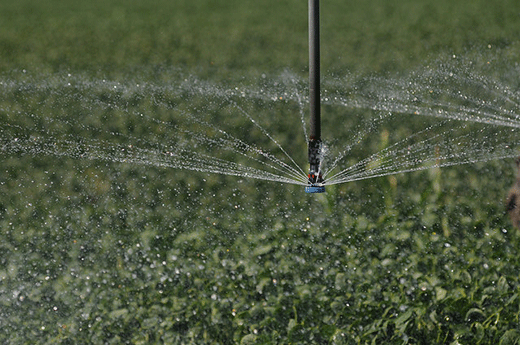
Voluntary water conservation efforts in western Kansas "are working out well," said K-State agricultural economist Bill Golden. | Download this photo.
Water conservation efforts also prove to be profitable, study shows
K-State ag economist outlines research on LEMAs in northwest Kansas
March 7, 2023
By Pat Melgares, K-State Research and Extension news service
MANHATTAN, Kan. – It’s been 10 years since the Kansas legislature passed a bill that gave groundwater management districts the authority to initiate voluntary steps to meet water conservation goals, and a Kansas State University agricultural economist says the state’s faith in farmers seems to be well placed.
Bill Golden said farmers in the Sheridan 6 Local Enhanced Management Area – a high priority area located within Groundwater Management District #4 in northwest Kansas – have reduced their water use by at least 20% compared to neighbors who have yet to commit to the LEMA. The original agreement began in 2013.
“I did an economic study between 2006 and 2013…and we predicted that farmers (participating in a LEMA) would lose money,” Golden said. “We thought that reducing water use was a great idea; it’s going to help the Ogallala Aquifer, but you’re going to lose some money.”
Listen to an interview by Samantha Bennett with Bill Golden on the weekday podcast, Agriculture Today
That has not turned out to be the case, according to Golden, who says that because they improved efficiency on their farm – such as taking advantage of available rainfall, implementing soil moisture monitors or changing their seeding and fertilizer rates – farmers actually are making more money on their cropland.
“At the end of the first five years (2018), the producers in Sheridan 6 decided to continue what they were doing,” Golden said. “In fact, Groundwater Management District No. 4 decided to have a district-wide LEMA.”
LEMAs became part of Kansas water law in 2012 when the state’s legislature passed SB 310. A LEMA is a producer-driven conservation program in which farmers form a contract with the Kansas Division of Water Resources to voluntarily reduce their use of water. The agreement can be for any amount of time and include whatever goals the farmers decide upon.
In the Sheridan 6 LEMA, farmers originally decided to reduce water use by 20% over five years, which amounted to an allocation of 55 inches of water per acre over a five-year period. Some years, they might use more of their allocation; other years, a little less.
“The Kansas Geological Survey monitors water levels in the Ogallala Aquifer and what they have found is that the levels used to drop 2-3 feet per year (prior to LEMAs),” Golden said. “Now, they’re finding that it’s dropping just 2-3 inches for the year. So in that area, we have nearly stabilized the depletion of the aquifer.”
Golden said farmers’ concerns at one time centered on a misunderstanding that the water in an aquifer moves quickly, which meant that if they didn’t use it today, it wouldn’t be there to use later on.
“But the Kansas Geological Survey has done a study that indicates that water is not moving (quickly),” Golden said. “The message for farmers is that the water you save today is going to be the water you can use next year or in 10 years from now, or 20 years from now.”
Golden said farmers also worried that using less water would reduce yields and thus make the value of land – particularly rented land – less valuable. But the most recent studies showing that farmers continue to produce good yields and be profitable while reducing water has debunked those thoughts.
“There’s not a lot of things wrong with the LEMA program and water conservation efforts in those areas right now,” Golden said. “They’re working out very well. It’s just a matter of how do you convince everybody to do it?”
Golden’s full report is available online. He also was a guest recently on Kansas State University’s weekday podcast, Agriculture Today.
More information is also available by contacting a Kansas watershed specialist, or the Kansas Center for Agricultural Resources and the Environment.

